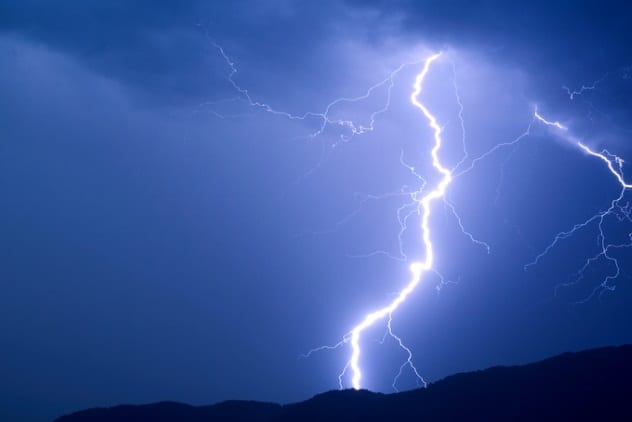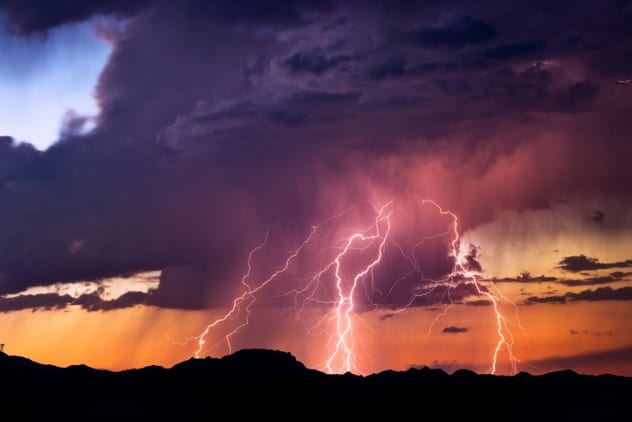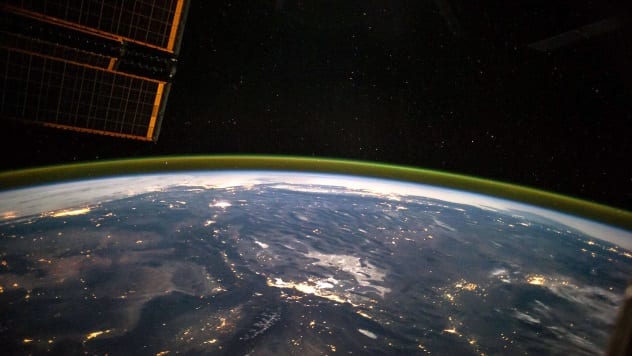 Mysteries
Mysteries  Mysteries
Mysteries  History
History 10 Surprising Stories About the Texas Rangers
 Humans
Humans 10 Philosophers Who Were Driven Mad by Their Own Theories
 Miscellaneous
Miscellaneous 10 Video-Game-Worthy Weapons and Armors from History
 Weird Stuff
Weird Stuff 10 Psychics Who Accurately Predicted Wartime Events
 The Arts
The Arts 10 Pieces of Art Inspired by a Broken Heart
 Health
Health 10 Science Fiction-Sounding New Medical Treatments
 History
History 10 Surprising Facts About the Father of Submarine Warfare
 Space
Space Ten Astonishing New Insights into Alien Worlds
 Weird Stuff
Weird Stuff 10 Bizarre Summer Solstice Rituals Still Practiced Today
 Mysteries
Mysteries Top 10 Haunting Facts About the Ghost Ship MV Alta
 History
History 10 Surprising Stories About the Texas Rangers
 Humans
Humans 10 Philosophers Who Were Driven Mad by Their Own Theories
Who's Behind Listverse?

Jamie Frater
Head Editor
Jamie founded Listverse due to an insatiable desire to share fascinating, obscure, and bizarre facts. He has been a guest speaker on numerous national radio and television stations and is a five time published author.
More About Us Miscellaneous
Miscellaneous 10 Video-Game-Worthy Weapons and Armors from History
 Weird Stuff
Weird Stuff 10 Psychics Who Accurately Predicted Wartime Events
 The Arts
The Arts 10 Pieces of Art Inspired by a Broken Heart
 Health
Health 10 Science Fiction-Sounding New Medical Treatments
 History
History 10 Surprising Facts About the Father of Submarine Warfare
 Space
Space Ten Astonishing New Insights into Alien Worlds
 Weird Stuff
Weird Stuff 10 Bizarre Summer Solstice Rituals Still Practiced Today
10 Most Intriguing Atmospheric Events That Could Happen Near You
Atmospheric phenomena occur constantly and in many forms. From rain to tornadoes, the phenomena generated in the layers of air around and above us often affect our lives, whether for good or for bad. However, there are some atmospheric events that remain hidden for most people, being so exceptional that even science struggles to explain them.
Due to their peculiar characteristics, a large number of natural events occur in specific areas of the Earth, where conditions are propitious.[1] But many atmospheric phenomena—including the rarest of all—are capable of occurring anywhere on our planet, at any time. So, as expected, this list compiles some of the most amazing and least known processes in the sky that humankind has witnessed, directly for your consideration.
10 Positive Superbolts

Normal lightning can contain a billion volts. Now imagine a lightning bolt 1,000 times more powerful than normal ones. Well, there you have a basic idea of what a superbolt is, possibly the most powerful lightning on Earth. And just as it is one of the most powerful, it is also one of the rarest. After its discovery, it was stated that five superbolts occur for every 10 million instances of common lightning.
Superbolts were first detected in the 1970s, when satellites in orbit recorded big electric discharges on the Pacific Ocean. Superbolts are a kind of lightning that originates in storms with positive electric charges. This is already different from normal lightning, which is formed with negative charges. But the weirdest thing is that these discharges are so powerful that they last longer than ordinary lightning, causing the superbolts to contain a huge amount of energy.
For that reason, it is known that superbolts are highly destructive, capable of destroying any building that is not prepared for such a discharge.[2] In 2012, Oklahoma residents woke up early in the morning when they heard a thunderous sound that set off car alarms in their neighborhood. At first, they thought it was an earthquake, until authorities confirmed that the cause of the ground tremor was a superbolt.
9 Ocean-Sucking Hurricanes

In September 2017, the inhabitants of the Bahamas were surprised when they saw that the ocean in front of them had suddenly disappeared.[3] All that remained was kilometers of dry seabed, as far as the eye could see. A few days later, the same thing happened along the coasts of Florida, where the water unexpectedly began to recede.
The reason behind this strange event was Hurricane Irma, one of the most powerful hurricanes ever recorded. In the eye, or the center of the storm, the atmospheric pressure was so low that the hurricane worked like a “vacuum cleaner” over the ocean. Thus, the storm absorbed seawater, accumulating it in its inner walls while it continued to advance. A small part of the ocean was dragged into the sky by the storm, and after a few days, the water was quickly returned to the seabed.
Hurricane Irma hasn’t been the only ocean-sucking storm. In fact, also in the Bahamas, another hurricane in 1936 sucked the adjacent oceanic area. The drying of the ocean floor really looks like a sign of an imminent tsunami. And although it is not, staying in that place for too long can be just as dangerous.
8 Crown Flashes
Let’s move to the state of Indiana to see another magnificent phenomenon. In June 2015, a small-time YouTuber was biking across the outskirts of Greenwood city. Suddenly, he saw in the sky what seemed to be a light between the clouds, moving from one place to another as if someone were there playing with a flashlight. The YouTuber, nicknamed QuadeM13, immediately recorded the event and uploaded it to the Web. Conspiracy theories did not take long to appear, but soon, everything was clarified with some scientific explanation.
The “dancing light” seen in the sky is actually a phenomenon known as a crown flash. Crown flashes are similar to another type of sky light called a sundog, the result of ice crystals in the air refracting sunlight. But unlike sundogs, crown flashes are dynamic lights which rotate and change their shape constantly. When lightning disturbs the electric field between the clouds, floating ice crystals realign with each discharge. As these crystals work as a “lens” that refracts sunlight, each time the crystals rotate, the beam of light also spins and moves, resulting in a crown flash.[4]
Crown flashes are extremely rare, although they can be generated in any thunderstorm. The first mention of this phenomenon dates back to 1885, but it is only in recent decades that we have been able to document crown flashes in visual media.
7 Meteors’ Bloody Rain

In Egypt, in the year 30 BC, there were “showers of blood mingled with water,” while “comets were observed in the heavens.” In AD 1017, a “comet” was seen in the sky of France for four months, and in the same year, “it rained blood.” In July 2001, red rain fell on Kerala in India, after locals reported having witnessed a meteor airburst in the sky.
As we can see, there are at least two points that these and similar stories have in common. On the one hand, the peculiar rains that fell on those occasions had an aspect like that of blood. And on the other hand, such rains were preceded by sightings of meteors or comets in the sky.
So in the first place, were those rains actually made of blood? Well, to date, it remains uncertain, but findings suggest that there is a correlation between such rains and living beings. Studies based on samples of the red rain from Kerala showed that the liquid contained traces of DNA. In turn, two scientists who participated in the research concluded that the total rain that fell that time contained about 50 metric tons of “biological cells.”[5]
Regarding whether the substance had an extraterrestrial origin, the cells are now believed to be from very terrestrial algae. Nevertheless, red rain has been touted as evidence in favor of the panspermia theory, which states that life on Earth originated in outer space.
6 Dry Microbursts

Microbursts are a type of wind current with great strength and short duration. This wind current descends vertically from storm clouds. When it hits the ground, it expands in all directions at around 160 kilometers per hour (100 mph), with very destructive power. Microbursts are so harmful that many people who were victims of the phenomenon believed at first that they had been hit by a tornado.
Microbursts originate when large clouds, usually cumulonimbus, enter a dry and cold air mass. This causes the ice crystals in the clouds to melt and cool the surrounding air. When cooled, this air goes down to the surface at high speed, often accompanied by abundant rain. While this type of microburst, aptly called a wet microburst, is easier to locate by the rain it carries, there is another type of current more undetectable and therefore more lethal: a dry microburst.
Dry microbursts differ from other types in that the rain evaporates before reaching the ground, due to the warmer air of the surface. This makes the microburst just a column of air, without any rain. Such wind will be impossible to see, but it will have the same destructive power as the other type of microburst.
In recent decades, there have been numerous air accidents caused by microbursts, leaving a total of about 500 fatalities.[6] Unfortunately, our knowledge about the formation of microbursts is still limited, so it is difficult to predict when and where they will occur.
5 Meteotsunamis

We all know tsunamis, giant waves caused by seismic movements. But an earthquake is not the only thing capable of causing tsunamis. In fact, there is an atmospheric phenomenon with the capacity to cause very large and destructive waves, properly called meteotsunamis. These waves should not be confused with storm surges, another type of wind-driven water phenomenon.
Meteotsunamis are a rare type of natural force which occurs when severe storm fronts cause differences in air pressure over the bodies of water. For this reason, a large wave is generated, which will move at the same speed as the storm. When the wave reaches the coast, it slows down and grows in height. Once on shore, the meteotsunami continues moving forward and destroying everything in its path, resulting in fatalities on many occasions.
The biggest meteotsunami ever recorded occurred in 1929 in the state of Michigan. It was 6 meters (20 ft) tall and killed ten people. In July 2018, a meteotsunami 1.5 meters (5 ft) high hit the coasts of Majorca, off the coast of Spain. Although it would seem that a wave like that is not so dangerous, the truth is that a German tourist died after being dragged out to sea by the water. Given their characteristics, meteotsunamis can be generated anywhere in the world, and scientists still do not know exactly how to predict their formation.[7]
4 Antimatter Storms

From Star Trek to Angels and Demons, countless films and science fiction works use antimatter as a main element in their plots. And antimatter also exists in the real world, in the form of a substance with a charge opposite to that of ordinary matter. The result is that when antimatter touches regular matter, both substances disintegrate violently and release a large amount of gamma rays in the process. These antimatter explosions could become our most powerful energy source, but unfortunately, creating antimatter is very expensive. However, we now know that antimatter seems to be a very common substance, and it is not necessary to go to another planet to find it.
Scientists know that lightning releases significant amounts of gamma rays. So in 2015, a team from the University of Kyoto placed several gamma ray detectors on the coasts of their country. In February 2017, these devices detected a few bursts of gamma radiation after a lightning strike. The largest burst, one minute long, was produced by the disintegration of nitrogen atoms. After being hit by gamma rays, these atoms became unstable and released positrons—the antimatter equivalent of electrons. In other words, reactions in thunderstorms produce antimatter, and when it touches normal atoms, even more gamma rays are released.
Teruaki Enoto, who leads the project, said the following after the discovery: “We have this idea that antimatter is something that only exists in science fiction. Who knew that it could be passing right above our heads on a stormy day?”[8] We also know that thunderstorms do not form only in our world—lightning has been detected on planets like Jupiter, so antimatter could be more common than we thought.
3 Megacryometeors

Imagine you are walking your pet, and you hear a strange noise that makes you look up to the sky. You see a big block of ice come crashing to the ground, leaving a large crater. That is what happened to a resident of Cape Coral, Florida, in June 2017. The cause of the strange event was an unusual natural phenomenon with the fancy name of megacryometeor, although it is better known as “chunk of ice that falls from the sky.”
Megacryometeors are huge ice stones with the same chemical composition as hail, although they are different from the latter. Megacryometeors can weigh hundreds of kilograms, like an ice block of 200 kilograms (440 lb) that fell in Brazil. No storm in the world can create such large hailstones.
If this is not strange enough, megacryometeors usually fall under clear sky conditions.[9] After establishing that neither a storm nor an airplane produces these chunks of ice, scientists believe that megacryometeors are formed in the lower stratosphere, between 10 and 20 kilometers (6–12 mi) high. With low ozone levels, ice forms high in the atmosphere and grows as it falls. Over recent decades, a few dozen cases of megacryometeors have been reported worldwide. But the scary thing is that these ice stones can fall anywhere, at any time of the day.
2 Bright Nights

Over the centuries, there have been times when the night sky was so bright that visibility was almost as good as during the day. In some cases, a person was able to read a book in the middle of the night or see objects hundreds of meters away, even without moonlight. For example, there are accounts from the first century BC about a “nocturnal sun” high in the sky. From the 18th to 20th centuries, stories about “bright nights” were repeated several times. Some theories have been proposed to explain these phenomena, from meteors to auroras, although none was sufficiently consistent with the records.
Now, scientists seem to have found the answer. During the day, ultraviolet radiation from the Sun decomposes the oxygen molecules present in the air of the atmosphere. But at night, hidden from sunlight, the oxygen atoms assemble again. By doing so, they release large amounts of energy in the form of particles called photons. The result is a green light in the sky, which can make the night sky to shine more than ten times above normal.[10]
Bright nights are a very strange phenomenon, representing only seven percent of the nights around the world. Old stories about bright nights are already few, and nowadays it is even more difficult than before to witness such events, due to the light pollution of big cities. Whoever is lucky enough to live in the right place will be able to see only one “bright night” per year.
1 Little Black Holes

Ball lightning is one of the most mysterious atmospheric phenomena for science. Although more than 10,000 instances of ball lightning have reportedly been seen around the world, scientists still cannot agree on what this phenomenon is. Most events have been reported as luminous spheres that move at ground level and disappear after a few seconds. Explanations for this phenomenon range from simple hallucinations to antimatter meteorites, none unanimously accepted. If you think that is already weird, well, it is about to get weirder. One theory states that ball lightning is actually black holes.
Mario Rabinowitz, from Stanford University, presented a report in 2001 about ball lightning being little black holes (LBHs). While a cosmic black hole has a huge diameter and the mass of many stars, an LBH has a subatomic diameter and a small mass, though it’s enough to emit radiation. When the LBH enters the Earth’s atmosphere, its stored energy is expelled in the form of radiation, ionizing the surrounding air and turning it into plasma. This is what gives ball lightning its luminous appearance. However, the LBH reaches a point where it loses too much energy to continue existing, vanishing with a violent explosion.[11]
Although this theory may seem a little far-fetched, many sightings are certainly consistent with its arguments. For example, we have a case that occurred in North Wales in 1992. An orb of ball lightning hit an oak tree and exploded, tearing the tree to pieces. The eyewitness to the event said that the ball lightning released “waves of lightning” in all directions while disappearing. This description is similar to the way plasma manifests in our atmosphere.
So, if you ever get to see ball lightning in person, remember how lucky (or maybe doomed) you are: There might be a little black hole right in front of you.
Economy student, passionate about Graphic Design, an avid enthusiast of the art of writing.
Read about more amazing aspects of our planet on 10 Real Places On Earth That Seem Scientifically Impossible and 10 Strange Earthly Mysteries That We Finally Understand.








